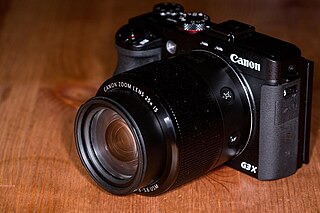Related Research Articles

The Memory Stick is a removable flash memory card format, originally launched by Sony in late 1998. In addition to the original Memory Stick, this family includes the Memory Stick PRO, a revision that allows greater maximum storage capacity and faster file transfer speeds; Memory Stick Duo, a small-form-factor version of the Memory Stick ; the even smaller Memory Stick Micro (M2), and the Memory Stick PRO-HG, a high speed variant of the PRO to be used in high-definition video and still cameras.

A memory card is an electronic data storage device used for storing digital information, typically using flash memory. These are commonly used in digital portable electronic devices. They allow adding memory to such devices using a card in a socket instead of a protruding USB flash drives.

CompactFlash (CF) is a flash memory mass storage device used mainly in portable electronic devices. The format was specified and the devices were first manufactured by SanDisk in 1994.

Secure Digital, officially abbreviated as SD, is a proprietary non-volatile flash memory card format developed by the SD Association (SDA) for use in portable devices.

The xD-Picture Card is an obsolete form of flash memory card, used in digital cameras made by Olympus and Fujifilm during the 2000s. The xD in the xD-Picture Card stands for eXtreme Digital.

P2 is a professional digital recording solid-state memory storage media format introduced by Panasonic in 2004, and especially tailored to electronic news-gathering (ENG) applications. It features tapeless (non-linear) recording of DV, DVCPRO, DVCPRO25, DVCPRO50, DVCPRO-HD, or AVC-Intra streams on a solid-state flash memory. The P2 card is essentially a RAID of Secure Digital (SD) memory cards with an LSI controller tightly packaged in a die-cast PC Card enclosure, so data transfer rate increases as memory capacity increases. The system includes cameras, decks as drop-in replacements for videocassette recorders (VCR), and a special 5.25-inch computer drive for random-access integration with non-linear editing systems (NLE). The cards can also be used directly where a PC card (PCMCIA) slot is available, as in most older notebook computers, as a normal hard disk drive, although a custom software driver must first be loaded.
Archos is a French multinational electronics company that was established in 1988 by Henri Crohas. Archos manufactures tablets, smartphones, portable media players and portable data storage devices. The name is an anagram of Crohas' last name. Also, in Greek (-αρχος), it's a suffix used in nouns indicating a person with power. The company's slogan has been updated from "Think Smaller" to "On The Go", and the current "Entertainment your way".

Lexar Media, Inc. is an American brand of flash memory products manufactured by the Chinese company Longsys.
This table provides summary of comparison of various flash memory cards, as of 2017.
AVCHD is a file-based format for the digital recording and playback of high-definition video. It is H.264 and Dolby AC-3 packaged into the MPEG transport stream, with a set of constraints designed around the camcorders.

SanDisk has produced a number of flash memory-based digital audio and portable media players since 2005. The current range of products bear the SanDisk Clip name, a line of ultraportable digital audio players. SanDisk players were formerly marketed under the Sansa name until 2014.

The SD Association (SDA) is an American nonprofit organization that sets memory card standards intended to simplify the use and optimize the performance of consumer electronics that people use in every country. SanDisk, Panasonic (Matsushita) and Toshiba formed the SD Association in January 2000. Today, the SDA has approximately 1,000 member companies involved in the design and development of SD standards. Thousands of device models and hundreds of products across dozens of product categories integrate the small, removable memory cards.
MOD and TOD are recording formats for use in digital tapeless camcorders. The formats are comparable to XDCAM EX, HDV and AVCHD.

The Samsung Galaxy Player is a line of Android-based all-purpose pocket computers produced by Samsung. The product was debuted on 2 September at the 2010 IFA in Berlin, and was showcased at the 2011 CES in Las Vegas.

The Panasonic Lumix DMC-GH2 is a digital camera with HD video recording capability that is part of the Micro Four Thirds system. Though commonly referred to as a DSLR camera, it has no mirror or optical viewfinder, but has instead both a fold-out LCD screen and a electronic viewfinder.

The HTC Evo 3D is a 3D-enabled Android smartphone developed by HTC, released exclusively in the United States through Sprint, and was re-released as a pre-paid smartphone by Virgin Mobile in May 2012 as the HTC Evo V 4G. A variation of Sprint's flagship HTC Evo 4G, the device is distinguished by its pair of 5 MP rear cameras, which can be used to take photos or video in stereographic 3D, which can be viewed on its autostereoscopic display without the need for 3D glasses. Several GSM variants are also available in Canada, Europe and Asia.

The Canon PowerShot G3 X is a large sensor digital bridge camera announced by Canon on June 18, 2015. It marks Canon's entry into this product category, alongside competitors such as the Panasonic Lumix DMC-FZ1000, Sony Cyber-shot RX10 and RX10 II.

ATP Electronics was a manufacturer of NAND based storage DRAM modules founded in Silicon Valley in 1991, headquarter was later moved to Taipei, Taiwan. ATP’s product line consist of Industrial grade products, such as SSD, SD / microSD memory cards, along with DRAM products that are used in business industries across Networking, Enterprise Mobility, Automotive industry, Military, IPC/Embedded Systems, Health care, Gaming and The Internet of Things (IoT). Intel's CMTL, one of the largest third party testing lab for Intel server platforms, only recommended two memory modules companies to purchase motherboards in Taiwan, one noted to be ATP Electronics.
References
- 1 2 "Panasonic Announces Dramatic Innovation in P2 Media with the Introduction of MicroP2 Card Series - Companion MicroP2 Card Adaptor Ensures Compatibility with Existing P2 Hardware". Archived from the original on April 18, 2012. Retrieved April 16, 2012.
- ↑ "Panasonic introduces new microP2 SD-sized storage at NAB 2012". Engadget.com. Retrieved 6 June 2016.
- ↑ "YouTube". Youtube.com. Retrieved 6 June 2016.
- ↑ "Panasonic's New Smaller, Faster, and Lower-Cost MicroP2 Cards Coming in April, Starting at $250". Nofilmschool.com. Retrieved 6 June 2016.
- 1 2 "Panasonic Announces April Delivery of Faster, Highly Reliable, Lower-Cost MicroP2 Card Series - World's First UHS-II Compliant Memory Cards". Archived from the original on May 26, 2013. Retrieved January 2, 2014.
- ↑ "InterBEE2012:Panasonic、P2 カードの後継規格「microP2 カード」を参考出品 - レポート - Macお宝鑑定団 blog(羅針盤)". Macotakara.jp. Retrieved 6 June 2016.
- 1 2 "microP2 Card - P2 Series - Broadcast and Professional AV". Pro-av.panasonic.net. Retrieved 6 June 2016.
